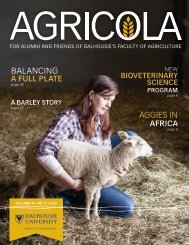SOYBEAN and BEES
BFhV4z
BFhV4z
Create successful ePaper yourself
Turn your PDF publications into a flip-book with our unique Google optimized e-Paper software.
Häusermann, 1960) <strong>and</strong> its presence can be identified only when nectar appears on the<br />
plant surface, or they can form anatomically distinct <strong>and</strong> sometimes highly conspicuous<br />
structures with a complex ultrastructure (Heil, 2011).<br />
Nectaries can be connected to the phloem, the xylem, both or have no direct vascular connection,<br />
as stated by Fahn (1988) <strong>and</strong> Wist <strong>and</strong> Davis (2006). The nectar exits through modified<br />
stomata that remain permanently open or through specialized trichomes (Fahn, 1988;<br />
Wist <strong>and</strong> Davis, 2006; Vassyliev, 2010; FRANCESCHI <strong>and</strong> GIAQUINTA, 1983). Such differences<br />
can even occur within the same plant <strong>and</strong> functional types of nectaries. For example,<br />
stipular extra-floral nectaries of cowpea (Vigna unguiculata) form an area of widely spaced<br />
secretory trichomes that lacks any direct connection to the vascular system, according to<br />
Kuo <strong>and</strong> Pate (1985). They also mention that extra floral nectaries on the inflorescence stalk<br />
consist of a region with secretory, cone-shaped tissues that are connected to the phloem <strong>and</strong><br />
release EFN through permanent1y open stomata.<br />
The nectary <strong>and</strong> gl<strong>and</strong>ular trichome secretions may be spatially <strong>and</strong> functionally timed <strong>and</strong>,<br />
therefore, may jointly contribute to the final nectar composition. Broersma et al. (1972), Levin<br />
(1973) <strong>and</strong> Rivera (1996) refers gl<strong>and</strong>ular floral <strong>and</strong> vegetative trichomes present on some<br />
species, which could be sites of production of anti- microbial compounds.<br />
Soybean nectaries <strong>and</strong> production of nectar<br />
In recent years, several studies targeted to elucidate the development <strong>and</strong> the functional<br />
features of nectaries (Durkee et al., 1981; Durkee, 1983; Dafni et al., 1988; Fahn, 1988;<br />
Beardsell et al., 1989; Figueiredo <strong>and</strong> Pais, 1992; Zer <strong>and</strong> Fahn, 1992; Rabinowitch et<br />
al., 1993; Belmonte et al., 1994; Stpiczynska, 1995; Nepi et al., 1996; O’Brien et al., 1996;<br />
Gaffal et al., 1998). While some investigation focus on the mature stage when nectar is present<br />
or on the whole composition of the nectar (Percival, 1961; Baker <strong>and</strong> Baker, 1981;<br />
Rabinowitch et al., 1993; Ecroyd et al., 1995; Davis, 1997; Carter et al., 1999; Carter <strong>and</strong><br />
Thornburg, 2000; Thornburg et al., 2003), others concentrate on nectar sugars content,<br />
like glucose, fructose, <strong>and</strong> sucrose, largely responsible for its functionality <strong>and</strong> characteristics<br />
(Butler et al., 1972; Baker <strong>and</strong> Baker, 1981; Roshchina <strong>and</strong> Roshchina, 1993).<br />
In spite that the family Fabaceae comprises several cultivated plants of economic importance,<br />
there have been relatively few (Ancibor, 1969; Waddle <strong>and</strong> Lersten, 1973; Gulyás<br />
<strong>and</strong> Kincsek, 1982) studies dealing with the development, anatomy, <strong>and</strong> ultrastructure of<br />
76 SoybeAn <strong>and</strong> bees






